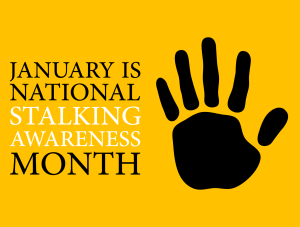January is Stalking Awareness Month – You Are Not Alone
 Did you know that 43% of college students have experienced activity that meets the legal definition of stalking but do not recognize their situation as a case of stalking?
Did you know that 43% of college students have experienced activity that meets the legal definition of stalking but do not recognize their situation as a case of stalking?
You may think stalking is something that happens to other people, but 1 in 3 women and 1 in 6 men experience stalking.2 Approximately 13.5 million people are stalked each year.3 As such, it helps to know what constitutes stalking and what your options are.
Stalking laws differ from one jurisdiction to another. However, broadly speaking, stalking can be defined as “a pattern of behavior directed towards an individual by another that results in the person to whom the behavior is directed fearing for themselves and/or others. The behaviors can involve overtly criminal behavior or seemingly non-criminal, innocent behavior or both.” There are a wide variety of behaviors that can constitute stalking. They include things like vandalism, waiting for someone or following them, sending unwanted gifts, unwanted attempts at contact through phone, text, social media, etc., using technology to gather information or images of the person being stalked, and numerous other activities.4 The Stalking Prevention, Awareness, and Resource Center (SPARC) groups stalking activities into four broad categories to help identify such activities: Surveillance, Life Invasion, Interference, and Intimidation.5
What should you do if you feel that you are being stalked? You have various options, but if you have an immediate concern for your safety contact your local police immediately. The SPARC website lists resources that may be helpful to you in processing what is happening and what potential next steps could look like.6 You can also contact me as the Title IX Coordinator for Union: pete.caccavari@myunion.edu or 513.487.1138. You are not alone; there are people willing to help you.
By Peter Caccavari
Associate Vice President for Institutional Effectiveness and Title IX Coordinator

1Brady, P. Q. & Woodward Griffin, V. (2019). The Intersection of Stalking and Sexual Assault Among Emerging Adults: Unpublished Preliminary Results, mTurk Findings, 2018. Referenced at The Stalking Prevention, Awareness, and Resource Center (SPARC). Accessed January 5, 2023. Campus Stalking Public Awareness Campaign.pdf
2Smith, S.G., Basile, K.C., & Kresnow, M. (2022). The National Intimate Partner and Sexual Violence Survey (NISVS): 2016/2017 Report on Stalking. Atlanta, GA: National Center for Injury Prevention and Control, Centers for Disease control and Prevention. Referenced at SPARC. Accessed January 5, 2023. General Stalking Infographic.pdf
3Smith, et al.
4Judicial Education Center, University of New Mexico. Accessed January 5, 2023.
5 SPARC. Accessed January 5, 2023. Identifying Stalking as SLII Strategies.pdf
6SPARC. Accessed January 5, 2023. stalkingawareness.org
___________________________________________________________________________________
Complete your degree at a university committed to social justice. Explore your career options at myunion.edu.